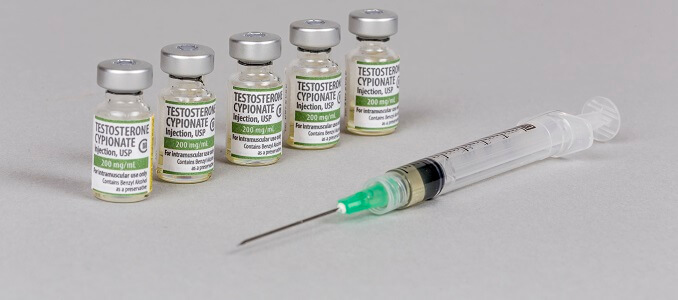Testosterone Therapy Results Before and After
The before and after results of testosterone replacement therapy have been well documented and can be life-changing for men and women with low testosterone.
As with any therapy or medication, your individual results of testosterone therapy will vary. However, when prescribed for low testosterone and taken as long as you follow your doctor’s instructions, most patients achieve remarkable results on testosterone therapy.
They have been enumerable studies both in the US and abroad that have clinically proven the many positive benefits of testosterone therapy for both men and women.
Testosterone Therapy Results Before and After
When wondering about the before and after results of testosterone treatment, one thing that you must keep in mind is that while you will see potentially dramatic results, you will not suddenly look like you did 20 years ago after your first low testosterone treatment. The whole reason why testosterone therapy is given as a program of weekly injections over a few months is that its effects are designed to be cumulative and take time to be achieved.
Testosterone therapy is available in several forms. Our doctors have found testosterone injections to be the most effective form of testosterone replacement therapy.
The before and after results of testosterone replacement therapy have been well documented.
What Happens When You Start Taking Testosterone?
One of the very first things that most people, and particularly men, notice when they start testosterone is an increase in sex drive. Women as well who start testosterone therapy report more “sexual fantasies” and spending more of their time during the day thinking about sex.
How soon and how your body reacts to testosterone largely depends on the dosage you are prescribed. However, that’s not to say more is better in the case of testosterone. In fact, you should never take more than your prescribed dose in the mistaken belief that you will get faster, better results. Everybody who has low testosterone is different. Testosterone therapy is not prescribed on a one-size-fits-all basis. Rather, your testosterone therapy will be prescribed based on your symptoms to achieve the optimal results for your particular needs and lifestyle.
How Long Does It Take to See Results on Testosterone?
Again, because every case of low testosterone is different and each of our bodies reacts to hormones differently, how long it will take for you to see the first results of testosterone replacement will vary. Generally speaking, you will start to notice some changes within the first two to four weeks on testosterone therapy.
A 2011 study on when to expect to see results from testosterone therapy found, “Effects on sexual interest appear after three weeks plateauing at six weeks, with no further increments expected beyond. Changes in erections/ejaculations may require up to 6 months. Effects on quality of life manifest within 3–4 weeks, but maximum benefits take longer. Effects on depressive mood become detectable after 3–6 weeks with a maximum after 18–30 weeks.”
The before and after results that anyone can expect on testosterone therapy will impact four major areas of your life:
- Physical strength
- Sexual performance
- Mental acuity
- Emotional wellbeing
Each month you are on testosterone, you will see increasing benefits impacting one or more of the areas of your life. Here is a month-by-month breakdown of the kind of results you can expect each month you are on testosterone.
The before and after testosterone therapy benefits take time to achieve.
Testosterone Therapy Results After One Month
During your initial four to six weeks of testosterone therapy, the first you will notice is significant increases in vitality and energy. You should also start to see:
- Improved mood
- Improved ability to focus and concentrate
- A reduction of belly fat
- Increased muscle mass
Testosterone Therapy Results After Two Months
Once you have completed two months of testosterone therapy, your ability to focus and concentrate will be greatly improved. This is the time in your program when you will start to see a definite “before and after” body in your mirror. Fat around your midsection should be significantly reduced, and your muscle tone will increase. Other results you can expect after two months of testosterone replacement therapy include:
- Improved sleep
- Continued improvements in libido or sex drive, increased number of spontaneous erections
- A reduction in cholesterol levels
- Increased stamina
- A reduction in systemic inflammation
Testosterone Therapy Results After Three Months
As you complete your third month of testosterone therapy, your benefits will continue to accumulate. In month three, you should see:
- Reduced anxiety and agitation
- Decreased total cholesterol and triglycerides (LDL levels may take a little longer)
- Increased HDL (good) cholesterol may begin at this point
- Improvements in glycemic control
- Increased red blood cell production
- Possible decline in diastolic blood pressure (maximum effects noted at 12-month mark)
- Better exercise capacity
Testosterone Therapy Results After Four Months
As you finish your third and enter your fourth month of testosterone therapy, in addition to continued improvements in strength, vitality, and sexual performance, you can expect the following additional before and after benefits of testosterone:
- Healthier hair
- Reduction of PMS symptoms (pre-menopausal women)
- Reduction of menopausal symptoms (menopausal and post-menopausal women)
- Improved bone health and bone density
Testosterone Therapy Results After Five Months
Although you are unlikely to see new benefits in month five, there will continue to be an overall strengthening of everything that has come before. You will barely be able to recognize the person you were before you started testosterone therapy.
Testosterone Therapy Results After Six Month
Once you are close to completing your first course of testosterone therapy in month 6, you will experience all of the many well-documented benefits of testosterone replacement therapy and an overall improved quality of life.
The complete list of positive results of testosterone therapy are as follows:
- Increased energy
- Improved mood
- Better memory and cognition
- Improved sex life
- Loss of fat, lower BMI, and increased lean muscle
- Reduced risk of cardiovascular disease
- A reduce your risk of osteoporosis
- An overall improvement of quality of life
After about six months you will achieve all of the many before and after results of testosterone therapy.
How Long Do the Results of Testosterone Therapy Last?
Testosterone therapy is an ongoing treatment that continues long-term. After your first six months of treatment, your hormone levels and symptoms will be reevaluated to see if you need to continue treatment. Most patients continue for at least another six months and spend a full year on treatment. After that, you will likely be evaluated every three months to see if you need to return to testosterone treatment. Once you complete your program, you will be given diet and lifestyle changes to make that will help to keep your testosterone levels high. However, as with most chronic conditions, stopping therapy could see your symptoms returning as testosterone levels once again fall below healthy levels.
What do the Studies Have to Say About Testosterone Results
Over the last few decades, testosterone replacement therapy has been studied extensively. There have been many studies in respected clinical journals that prove the before, and after results, you can expect with testosterone therapy.
A 2018 study concluded, “testosterone replacement therapy had multiple positive effects on affected men with [low testosterone]. Our long-term results showed a long-lasting improvement during the time [the subjects were on testosterone]. Authors concluded that long term treatment had multiple benefits for affected the men.”
A study in 2014 on obese men with low testosterone and erectile dysfunction concluded, “Long-term testosterone replacement in men with low testosterone and ED reduces obesity parameters and improves metabolic syndrome and health-related quality of life.”
The results of an eight-year study that was published in 2016 found that “Long-term testosterone treatment in men with low testosterone up to 8 years appears to be safe, tolerable, and effective in correcting obesity parameters, urinary symptoms, bone mineral density, and sexual function in men with late-onset hypogonadism.”
This is just a small sample of the countless clinical trials that have proven the many positive before and after results of testosterone replacement therapy.
FAQs
What is testosterone therapy?
Testosterone therapy is used to treat men and women who have been diagnosed with low testosterone. Testosterone therapy is designed to make you feel younger, stronger, and improve your confidence, so you can continue to do all the things you enjoy most in life.
What causes low testosterone?
Any disease or condition that impairs your body’s ability to produce testosterone can lead to hypogonadism or low testosterone. Some cancers can do this, as can other conditions or injury to the testes. However, the most common cause of low testosterone is the natural decline in testosterone that occurs as men age. Testosterone production continues through adolescence until it reaches its highest level at about the age of eighteen. In most men, their testosterone levels will stay at or pretty close to that maximum level through their 20s. Then, once you are over 30, your testosterone level will start on a steady downward slope. By the time you are over 40, most men will be feeling the negative impacts of low testosterone.
What are the symptoms of low testosterone?
The signs and symptoms of low testosterone, also known as Low-T include:
- A decrease in libido or sex drive
- An overall feeling of reduced virility and vigor
- Changes in mood
- Erectile dysfunction
- Loss of stamina
- Loss of muscle tone
- Weight gain
- Loss of memory and other cognitive issues
How is low testosterone diagnosed?
Usually, a simple blood test that measures your testosterone level is all that is needed to receive a diagnosis of low testosterone.
How low does your testosterone level need to be to require treatment?
While there are clinical guidelines that define low testosterone, it is hard to say how low your testosterone has to be to require treatment. This is because testosterone levels are very individual. What is normal for you could be fine for someone else. All men will lose testosterone as they age. Some men will barely notice the loss. For others, the deficiency can be devastating. So, rather than speaking of normal levels, it is better to think in terms of symptoms. If you are exhibiting the signs of low-T, your levels are probably low enough to need treatment.
Now that you know a little bit more about the before and after results of testosterone replacement therapy, why not take a minute to contact us and learn more about how hormone replacement therapy can improve your quality of life?





